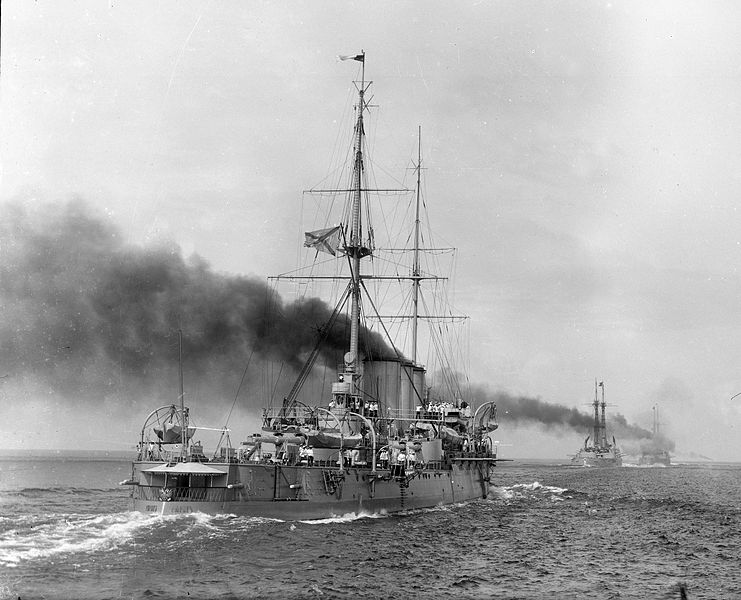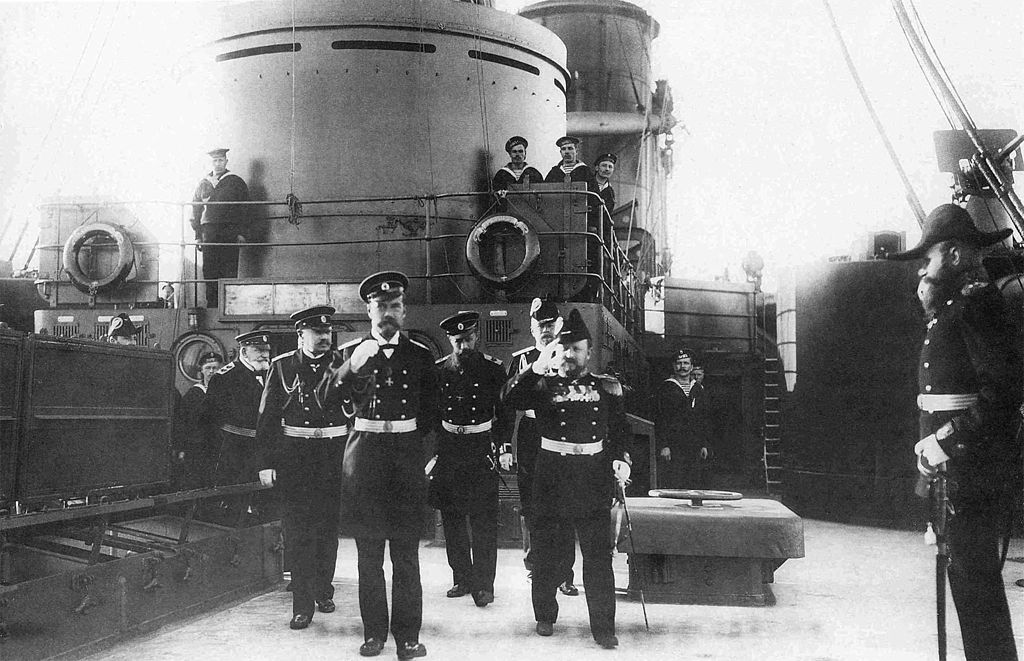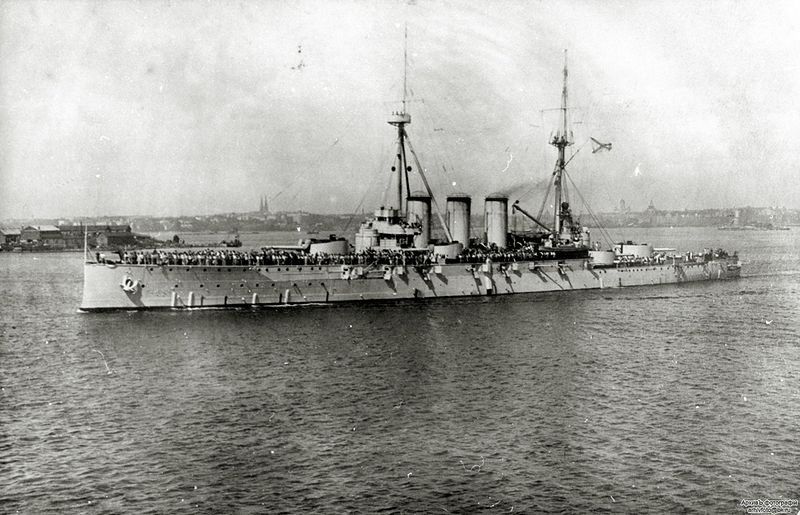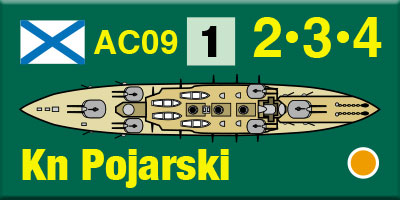Jutland: The Baltic Sea
Armored Cruiser Rurik and Her Sisters
by Mike Bennighof, Ph.D.
March 2025
 Both Russia and Japan reacted to the first naval clashes of the Russo-Japanese War by ordering new heavy ships to new designs influenced by the experience of war. In particular, the lessons seemed to point to the need for larger armored cruisers armed with heavier guns. And so in June 1904 the Imperial Japanese Navy ordered the Tsukuba class of two armored cruisers bearing 12-inch guns. Both Russia and Japan reacted to the first naval clashes of the Russo-Japanese War by ordering new heavy ships to new designs influenced by the experience of war. In particular, the lessons seemed to point to the need for larger armored cruisers armed with heavier guns. And so in June 1904 the Imperial Japanese Navy ordered the Tsukuba class of two armored cruisers bearing 12-inch guns.
In July 1904 the Russians reacted with a brief design competition, won by the British firm of Vickers-Barrow represented by the international arms dealer and man of mystery, Basil Zaharoff. The Russians signed a purchase agreement for one ship on 31 May 1905, with a delivery date of 1 March 1907.
Unlike previous armored cruisers, the new ship – named Rurik in honor of an older cruiser sunk by the Japanese in August 1904 - would be battleship-sized and theoretically capable of either standing in the line or battle or acting in a “fast wing” of the battle fleet. The initial design called for a main armament of four 254mm (10-inch) guns fore-and-aft in twin turrets, and a dozen 203mm (8-inch) guns in six twin turrets, three along either side. For protection against enemy torpedo boats, the ship would have twenty 76.2mm (3-inch) guns in casemates.
Though expected to fight battleships, the new cruiser carried armor only proof against the guns of enemy cruisers: eight inches on the 254mm turrets and seven inches on the main turret barbettes and the 203mm turrets and six inches on the 203mm barbettes and the main armor belt. Her 28 boilers powered two triple-expansion engines, delivering 19,700 horsepower for a designed speed of 21 knots.

Rurik trails Andrei Pervozvanny on fleet maneuvers, 1913.
Almost immediately, the Russians began meddling with the design, a common practice with Russian yards (which led to lengthy completion times for some ships) but not for British shipbuilders. The armament changed to eight 203mm guns in four twin turrets, with the 76.2mm guns upgraded to 120mm pieces. The Vickers-designed turrets were to be replaced with models similar to those on the new battleship Andrei Pervozvanny. As construction proceeded the Russians continued to demand changes, at first to the armor scheme and then a switchover from traditional triple-expansion engines to new turbines, raising horsepower to 42,000 and the designed speed from 21 to 25 knots.
Vickers argued that they could not change the propulsion system without disassembling the steel already erected and starting construction anew, but the Russians accepted this argument only grudgingly. The ship finally launched in November 1906 and began sea trials in July 1907 without her armament. Gunnery trials began in the spring of 1908, under the direction of a Russian supervisor, Vladimir Kostenko. Kostenko, then just 27 years old, had written his dissertation on the concept of a high-speed armored cruiser very similar to the proposed modifications of Rurik, but had spent two years in Japanese captivity and then overseen construction of the new battleship Andrei Pervozvanny.
The new ship soon showed severe problems with the barbettes supporting her 254mm and 203mm turrets. Firing the main armament opened seams in the hull, requiring extensive modifications before the Russians would accept her. When not rejecting Vickers’ solutions to the problem, Kostenko spent his time enlisting the ship’s crew in the Socialist Revolutionary Party and fomenting a scheme to assassinate Tsar Nicholas II when he came to welcome the new ship to Russia.

Tsar Nicholas II welcomes Rurik to Russia, 1908; the Tsar survived the visit.
Kostenko’s plot failed, and he was later arrested but then pardoned by the Tsar and returned to designing warships and overseeing their construction. Meanwhile Rurik continued to have problems with her barbettes and, with Vickers’ assistance, the massive structures and the turrets topping them were removed at Kronstadt and their fittings re-built. The ship finally entered Russian service in July 1909, but the Tsar’s officers remained unhappy with their new cruiser; an agreement to reduce her purchase price left neither side satisfied.
Vickers provided no spare gun barrels for the 254mm guns, and extensive firing trials and gunnery drills soon wore out those with which she had arrived in Russia. The local Obukhov Works had difficulties providing replacements and could not deliver the first four until late 1915, forcing the ship to undertake her initial missions in the Great War with worn-out guns. They fared little better with the 203mm guns, not delivering new barrels until May 1915.
The advent of the British battle cruiser Invincible in the spring of 1908, over a year before Rurik’s acceptance, enraged the Russians who felt (with some justification) that Vickers had sold them an inferior ship in the full knowledge that she would be obsolete before she was even commissioned. Plans to build two more ships to Rurik’s plans in Russian shipyards were cancelled.
Russian naval architects continued to seek to make Rurik a first-line warship, and when she went to the Baltic Yard in Petrograd in late 1916 following heavy damage from a mine they floated a renewed proposal to replace her engines with turbines, bringing her speed to 25 knots. That plan came to nothing – with the country falling apart, no such turbines could have been built nor did the shipyard have the labor force to install them.

Rurik at Revel (Talinn, Estonia), 1917.
Despite her worn-out guns, Rurik served as Baltic Fleet commander Nikolai Essen’s flagship and saw extensive action in the war’s opening months covering minelaying operations and attempting to interdict German convoys. She fought German cruisers several times, including a gunnery duel with the German armored cruiser Roon in July 1915. She suffered extensive damage from grounding twice, and though repaired her use fell off as the war progressed. Her crew showed revolutionary symptoms early on, and rather than stick around and hold meetings as occurred in the other large warships most of Rurik’s crew, including her commander, simply left.
Brought to Kronstadt from Helsinki in early 1918, by October she was no longer serviceable. The Bolsheviks earmarked her for modernization in 1922, but no regular maintenance had been performed and sea water had flooded much of the ship. With rebuilding out of the question, she was towed to the former Admiralty Shipyard and scrapped there in 1923.

Rurik appears in Great War at Sea: Jutland; her projected sister ships are found in Jutland: Baltic Sea.
You can order Jutland: Baltic Sea right here.
Please allow an extra six weeks for delivery.
Sign up for our newsletter right here. Your info will never be sold or transferred; we'll just use it to update you on new games and new offers.
Mike Bennighof is president of Avalanche Press and holds a doctorate in history from Emory University. A Fulbright Scholar and NASA Journalist in Space finalist, he has published a great many books, games and articles on historical subjects; people are saying that some of them are actually good.
He lives in Birmingham, Alabama with his wife, three children, and new puppy. He misses his lizard-hunting Iron Dog, Leopold.
Daily Content includes no AI-generated content or third-party ads. We work hard to keep it that way, and that’s a lot of work. You can help us keep things that way with your gift through this link right here.
|
